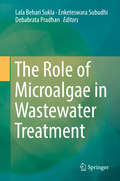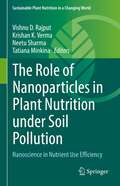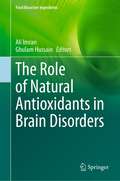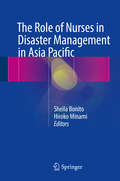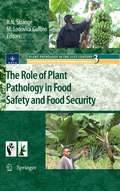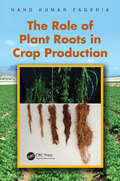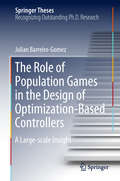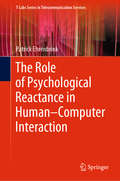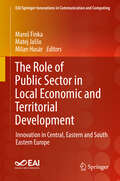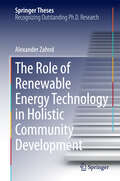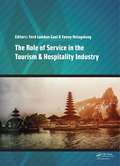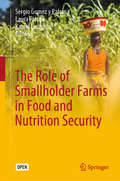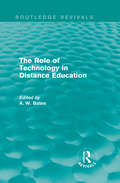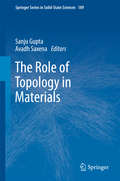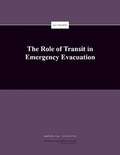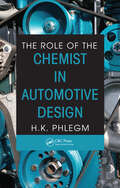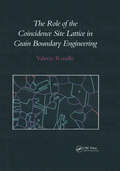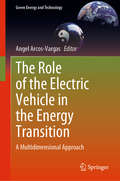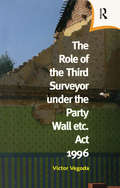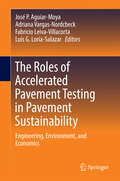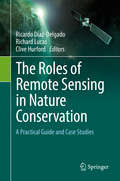- Table View
- List View
The Role of Microalgae in Wastewater Treatment
by Lala Behari Sukla Debabrata Pradhan Enketeswara SubudhiThis book deals with the most emerging aspects of algal research with special reference to microalgae viz; diversity, mutations, genomics and metagenomics study, eco-physiology, culturing, microalgae for food and feed, biofuel production, harvesting of microalgae, separation, and purification of biochemicals, techno-economical assessment, microalgal biotechnology, algal-bacterial systems for wastewater treatment. It describes the complex issues associated with the above-mentioned areas with the intervention of cutting-edge biotechnological tools and techniques like next-generation sequencing methods, metabolomics, and bioreactor design and development. The chapters provide past developments, current information and future prospects of algal technology as an alternate avenue for waste water treatment and its potential for production of biofuel and nutraceuticals.
The Role of Nanoparticles in Plant Nutrition under Soil Pollution: Nanoscience in Nutrient Use Efficiency (Sustainable Plant Nutrition in a Changing World)
by Neetu Sharma Vishnu D. Rajput Tatiana Minkina Krishan K. VermaNanotechnology has shown great potential in all spheres of life. With the increasing pressure to meet the food demands of rapidly increasing population, thus, novel innovation and research are required in agriculture. The principles of nanotechnology can be implemented to meet the challenges faced by agricultural demands. Major challenges include the loss of nutrients in the soil and nutrient-deficient plants, which result in a lower crop yield and quality. Subsequently, consumption of such crops leads to malnourishment in humans, especially in underprivileged and rural populations. One convenient approach to tackle nutrient deficiency in plants is via the use of fertilizers; however, this method suffers from lower uptake efficiency in plants. Another approach to combat nutrient deficiency in humans is via the use of supplements and diet modifications; however, these approaches are less affordably viable in economically challenged communities and in rural areas. Therefore, the use of nano-fertilizers to combat this problem holds the greatest potential. Additionally, nanotechnology can be used to meet other challenges in agriculture including enhancing crop yield, protection from insect pests and animals, and by use of nano-pesticides and nano-biosensors to carry out the remediation of polluted soils. The future use of nanomaterials in soil ecosystems will be influenced by their capability to interact with soil constituents and the route of nanoparticles into the environment includes both natural and anthropogenic sources. The last decade has provided increasing research on the impact and use of nanoparticles in plants, animals, microbes, and soils, and yet these studies often lacked data involving the impact of nanoparticles on biotic and abiotic stress factors. This book provides significant recent research on the use of nano-fertilizers, which can have a major impact on components of an ecosystem. This work should provide a basis to further study these potential key areas in order to achieve sustainable and safe application of nanoparticles in agriculture.
The Role of Natural Antioxidants in Brain Disorders (Food Bioactive Ingredients)
by Ghulam Hussain Ali ImranOxidative stress and neuroinflammation are considered causative factors in various neurological disorders such as Parkinson’s and Alzheimer’s diseases. Antioxidants are chemicals that bind with oxidative species and nullify their effect from causing damage to biological molecules. Endogenous antioxidants are produced by our body, however most of them are obtained from external sources, primarily through diet, called dietary antioxidants. Major sources of antioxidants are brightly colored fruits, vegetables, cereals, legumes, and herbs. Other very effective sources are berries, green tea, and dark chocolate. These compounds have the potential to hinder neurodegeneration, reduce neuronal death and improve memory as well as cognitive functions. Based on the complex nature of antioxidants and oxidative stress, particular antioxidants such as vitamin E, vitamin C or β-carotene are beneficial in protecting cells, organs and tissues against oxidative damage.The Role of Natural Antioxidants in Brain Disorders describes various neuroprotective effects and their physiological phenomenon mediated by antioxidants to maintain and regulate the general health biomarkers against brain disorders. The important role of antioxidants, diet and lifestyle in managing brain disorders is covered, as is their use in conjunction with conventional therapies against oxidative stress. Both exogenous and endogenous antioxidants are explored in full. By focusing on the role of oxidative stress as a triggering mechanism for various brain disorders and the use of antioxidant foods in conjunction with traditional therapies in combating and preventing them, this is a valuable source for researchers in food science, nutrition, health science and physiology.
The Role of Nurses in Disaster Management in Asia Pacific
by Sheila Bonito Hiroko MinamiThis book documents how nurses have shown their dedication, courage, expertise and compassion in helping communities prepare for, respond to and recover from disastrous events. It aims to inspire and equip nurses and other health professionals to help people in disaster-affected areas and contribute to community resilience. The last decade (2005-2015) has been characterized by a number of overwhelming natural disasters - tropical storms, floods, earthquakes, tsunamis; and threats of emerging infectious diseases - SARS, MERSCoV and Ebola around the world. Countries from the Asia Pacific region, such as Australia, Cambodia, China, Indonesia, India, Japan, Nepal, Philippines, Solomon Islands, South Korea, Thailand and Vanuatu, have borne the brunt of the devastation caused by these catastrophic events. Nurses from these countries have stepped in providing emergency care in hospitals and in the field, addressing public health needs in evacuation centers, supporting epidemiologic surveillance and conducting health education, training and research, to help save lives and support communities build back better.
The Role of Plant Pathology in Food Safety and Food Security
by Maria Lodovica Gullino R. N. StrangeThis book views the vulnerability of our crops in general to devastating diseases as well as specifically the disease problems of two important staples, rice and cassava. Increased travel and increased transport of plant material throughout the world pose ever more significant risks to the health of our plants. These include not only the destruction of our food crops by pathogens which may be imported accidentally or maliciously but also their contamination by fungi that produce powerful toxins (mycotoxins). How we should respond to these challenges is the subject of several papers. Clearly, quarantine is an important measure by which the spread of plant pathogens may be at least delayed, if not curtailed altogether, but breeding plants for resistance is the mainstay for maintaining the comparative health and productivity of our crops. However, adequate resistance may not be available in the gene pool of a given species or genus and therefore the possibility of genetic modification arises, a topic treated in two of the papers.
The Role of Plant Roots in Crop Production
by Nand Kumar FageriaThe Role of Plant Roots in Crop Production presents the state of knowledge on environmental factors in root growth and development and their effect on the improvement of the yield of annual crops. This book addresses the role of roots in crop production and includes references to numerous annual crops. In addition, it brings together the issues and
The Role of Population Games in the Design of Optimization-Based Controllers: A Large-scale Insight (Springer Theses)
by Julian Barreiro-GomezThis book reports on the implementation of evolutionary-game theory in the design of distributed optimization-based controllers. First, it discusses how the classical population-game approach can contribute to and complement the design of optimization-based controllers. It shows how the features of this approach can be exploited to extend their capabilities in the solution of distributed optimization problems, and examines density games in order to consider multiple coupled constraints and preserve the non-centralized information requirements. Furthermore, it establishes a close relationship between the possible interactions among agents in a population with constrained information sharing among different local controllers. It also discusses coalitional games, focusing on the Shapley power index and proposes an alternative method of computing the latter, which reduces computational time, as well as a different way of finding it using distributed communication structures. All the proposed strategies are then tested on various control problems, such as those related to the Barcelona water supply network, multiple continuous stirred tank reactors, various unmanned aerial vehicle systems, and a water distribution system. This thesis, examined at the Universitat Politècnica de Catalunya and Universidad de los Andes in 2017, received the award for best thesis in control from the control group of the Spanish Committee of Automatic Control (CEA) in the same year.
The Role of Prototypes in Design Research: Overview and Cases Studies (SpringerBriefs in Applied Sciences and Technology)
by Silvia D. FerrarisThis book provides a theoretical framework for design researchers interested in developing their research work about and with prototypes. It describes prototypes' multiple definitions and possible functions in the multifaceted landscape of today's design research. Indeed, while the manufacturing and digital evolutions enable and require new types of advanced prototypes, the design evolution as an academic discipline continuously widens its perspectives, fields, and research methods, among which are the prototypes' applications, features, and purposes. The framework originates from an interpretation of these interrelated phenomena and a collection of case studies. Additionally, it defines those criteria that characterize the relation between the research (context, discipline, and general scope) and the prototype (nature and specific aims) and, altogether, it presents an overview of prototypes' roles in design research.
The Role of Psychological Reactance in Human–Computer Interaction (T-Labs Series in Telecommunication Services)
by Patrick EhrenbrinkThis book provides an in-depth investigation on the psychological phenomenon "reactance“ in the context of Human-Computer Interaction (HCI). The author argues that the complexity and autonomy of modern technology can sometimes be overwhelming and can then be perceived as a threat to freedom by its users, thereby diminishing acceptance. The book investigates if and how this is the case and provides strategies to regain the lost acceptance. Topics include relevance of reactance on HCI, triggers for reactance, consequences of reactance, measurement of reactance, and countermeasures to reactance.
The Role of Public Sector in Local Economic and Territorial Development: Innovation in Central, Eastern and South Eastern Europe (EAI/Springer Innovations in Communication and Computing)
by Maroš Finka Matej Jaššo Milan HusárThe book covers the topic of the role of public sector in the economic and territorial development across several dimensions of spatial planning, e.g. theoretical-methodological (planning cultures, leadership), executive (regional policies, services of general interest), sectoral (energy, tourism, air-quality) or social (social innovation, preservation of cultural heritage). The book delivers up-to date knowledge build on interactions between representatives of different stakeholders of economic and territorial development with the research represented by renowned experts and academicians. This is mirrored in the content of the book, delivering in a consistent form the conceptual explanations combined with the examples of the role of the public sector in fostering the local economies within the frame of spatial planning. The book reflects and transfers the expert knowledge which has been generated during more than a decade of scientific and research activities of Spa-ce.net.Presents a comprehensive view on different aspects of the involvement of public sector in the local and regional spatial development;Includes a combination of macro-regionally specific perspectives with the generalized knowledge;Provides knowledge from various researchers from prestigious European scientific and research teams.
The Role of Renewable Energy Technology in Holistic Community Development
by Alexander ZahndThis thesis documents almost twenty years of the author's work on the development and implementation of a new approach to holistic community development in remote and disadvantaged villages in Nepal. It describes the theoretical basis of the work, the main research activities, and the practical outcomes of the implemented programs. One of the fundamental cornerstones of holistic community development is the provision of appropriate and sustainable solutions for the long-term development of local communities. This requires that people's own identified needs be recognized and addressed in partnership with them in holistic ways. The author explains the many synergies that result from this holistic approach to community development. Another cornerstone of his approach is to utilise the communities' locally available renewable resources for long-term sustainable development. One of the key findings of the thesis is that improved access to energy services, such as cooking with a smokeless metal stove in a clean indoor environment, basic indoor lighting, and increased food production and safe food storage (through a greenhouse and a solar drier respectively), need to be at the very heart of any long-term holistic community development project. The thesis demonstrates that tapping into locally available renewable energy resources and converting them, through contextualized and locally manufactured renewable energy technologies, has a central role in long-term holistic community development programs. Such programs are successful because they provide both appropriate technologies and life-changing experiences for the local users involved.
The Role of Service in the Tourism & Hospitality Industry: Proceedings of the Annual International Conference on Management and Technology in Knowledge, Service, Tourism & Hospitality 2014 (SERVE 2014), Gran Melia, Jakarta, Indonesia, 23-24 August 2014
by Ford Lumban Gaol Fonny HutagalungThis proceedings volume contains papers presented at the 2014 International Conference on Management and Technology in Knowledge, Service, Tourism & Hospitality (SERVE 2014), covering a wide range of topics in the fields of knowledge and service management, web intelligence, tourism and hospitality. This overview of current state of affair
The Role of Smallholder Farms in Food and Nutrition Security
by Sergio Gomez y Paloma Laura Riesgo Kamel LouhichiThis open access book discusses the current role of smallholders in connection with food security and poverty reduction in developing countries. It addresses the opportunities they enjoy, and the constraints they face, by analysing the availability, access to and utilization of production factors. Due to the relevance of smallholder farms, enhancing their production capacities and economic and social resilience could produce positive impacts on food security and nutrition at a number of levels.In addition to the role of small farmers as food suppliers, the book considers their role as consumers and their level of nutrition security. It investigates the link between agriculture and nutrition in order to better understand how agriculture affects human health and dietary patterns. Given the importance of smallholdings, strategies to increase their productivity are essential to improving food and nutrition security, as well as food diversity.
The Role of Technology in Distance Education (Routledge Revivals)
by Tony BatesThis book, first published in 1984, provides a comprehensive review of the range of technology that was being used in distance education. Technological developments in word processing, video-disc and viewdata as well as computer-based learning had revolutionised the potential for distance education. These developments required the role of more ’conventional’ distance learning media, such as broadcasting, tuition and text, to be reassessed. This book, written by international experts in the field, explored the state of the art at the time, and also provided their ideas on how future developments were likely to evolve. This book is ideal for those studying education and communications.
The Role of Technology in Science: Philosophical Perspectives
by Sven Ove HanssonThis edited volume explores the interplay between philosophies in a wide-ranging analysis of how technological applications in science inform our systems of thought. Beginning with a historical background, the volume moves on to explore a host of topics, such as the uses of technology in scientific observations and experiments, the salient relationship between technology and mechanistic notions in science and the ways in which today's vast and increasing computing power helps scientists achieve results that were previously unattainable. Technology allows today's researchers to gather, in a matter of hours, data that would previously have taken weeks or months to assemble. It also acts as a kind of metaphor bank, providing biologists in particular with analogies (the heart as a 'pump', the nervous system as a 'computer network') that have become common linguistic currency. This book also examines the fundamental epistemological distinctions between technology and science and assesses their continued relevance. Given the increasing amalgamation of the philosophies of science and technology, this fresh addition to the literature features pioneering work in a promising new field that will appeal both to philosophers and scientific historiographers.
The Role of Topology in Materials (Springer Series In Solid-state Sciences Ser. #189)
by Avadh Saxena Sanju GuptaThis book presents the most important advances in the class of topological materials and discusses the topological characterization, modeling and metrology of materials. Further, it addresses currently emerging characterization techniques such as optical and acoustic, vibrational spectroscopy (Brillouin, infrared, Raman), electronic, magnetic, fluorescence correlation imaging, laser lithography, small angle X-ray and neutron scattering and other techniques, including site-selective nanoprobes. The book analyzes the topological aspects to identify and quantify these effects in terms of topology metrics. The topological materials are ubiquitous and range from (i) de novo nanoscale allotropes of carbons in various forms such as nanotubes, nanorings, nanohorns, nanowalls, peapods, graphene, etc. to (ii) metallo-organic frameworks, (iii) helical gold nanotubes, (iv) Möbius conjugated polymers, (v) block co-polymers, (vi) supramolecular assemblies, to (vii) a variety of biological and soft-matter systems, e.g. foams and cellular materials, vesicles of different shapes and genera, biomimetic membranes, and filaments, (viii) topological insulators and topological superconductors, (ix) a variety of Dirac materials including Dirac and Weyl semimetals, as well as (x) knots and network structures. Topological databases and algorithms to model such materials have been also established in this book. In order to understand and properly characterize these important emergent materials, it is necessary to go far beyond the traditional paradigm of microscopic structure–property–function relationships to a paradigm that explicitly incorporates topological aspects from the outset to characterize and/or predict the physical properties and currently untapped functionalities of these advanced materials. Simulation and modeling tools including quantum chemistry, molecular dynamics, 3D visualization and tomography are also indispensable. These concepts have found applications in condensed matter physics, materials science and engineering, physical chemistry and biophysics, and the various topics covered in the book have potential applications in connection with novel synthesis techniques, sensing and catalysis. As such, the book offers a unique resource for graduate students and researchers alike.
The Role of Transit in Emergency Evacuation
by Transportation Research BoardTRB Special Report 294: The Role of Transit in Emergency Evacuation explores the roles that transit systems can play in accommodating the evacuation, egress, and ingress of people from and to critical locations in times of emergency. The report focuses on major incidents that could necessitate a partial to full evacuation of the central business district or other large portion of an urban area. According to the committee that produced the report, transit agencies could play a significant role in an emergency evacuation, particularly in transporting carless and special needs populations, but few urban areas have planned for a major disaster and evacuation that could involve multiple jurisdictions or multiple states in a region, or have focused on the role of transit and other public transportation providers in such an incident. The report offers recommendations for making transit a full partner in emergency evacuation plans and operations, while cautioning emergency managers, elected officials, and the general public to be realistic in their expectations, particularly in a no-notice incident that occurs during a peak service period.
The Role of the Chemist in Automotive Design
by H. K. PhlegmFrom the development of polymers that make cars lighter to fuels that make them run cleaner, the chemist‘s role in the automotive industry has evolved to be one that is more outside the laboratory than in it. Drawing on the author‘s 20 years of experience in vehicle design and laboratory experience, The Role of the Chemist in Automotive
The Role of the Coincidence Site Lattice in Grain Boundary Engineering
by V. RandleFirst published in 1997. This monograph provides a complete overview of the coincidence site lattice model ad its application to grain boundary engineering. Originally propounded several decades ago, the coincidence site lattice (CSL) model has become a cornerstone of grain boundary structure research, particularly in cubic materials. The CSL model has the advantage of being used based on a simple geometrical concept which is easy to visualise and apply in practice. On the other hand here are limitations to the links between CSL geometry and boundary properties. However, with the advent of the new field of grain boundary engineering the CSL model has been shown to be useful and its is therefore timely to review the CSL model in this context.
The Role of the Electric Vehicle in the Energy Transition: A Multidimensional Approach (Green Energy and Technology)
by Angel Arcos-VargasThis book explores the part that electric vehicles can play in reducing carbon dioxide emissions. Further, it explains the impact of public support, technological advances, lower costs and better battery performance in making electric vehicles a viable alternative. The book begins by analyzing the international context of electric vehicles and how they are being developed in different countries, and by offering a forecast of the electricity demand they may create. It then discusses technological innovations in electric vehicle recharging systems. The book is concerned not only with the economic potential of electric vehicles, but also with environmental aspects; consequently, it examines the raw materials supply chain and performs a lifecycle assessment. The book concludes with a chapter on alternative energies in transport, which may also help to facilitate the energy transition. Given its scope, the book offers a valuable resource for researchers, graduate students, policymakers and industry professionals interested in the energy transition and transport.
The Role of the Third Surveyor under the Party Wall Act 1996
by Victor VegodaThis book is intended to clear any misconceptions about the responsibilities of the third surveyor and outlines the steps taken in choosing a professional for this role, as well as discussing who may carry it out.
The Roles of Accelerated Pavement Testing in Pavement Sustainability
by José P. Aguiar-Moya Adriana Vargas-Nordcbeck Fabricio Leiva-Villacorta Luis G. Loría-SalazarThis compendium gathers the latest advances in the area of Accelerated Pavement Testing (APT), a means of testing full-scale pavement construction in an accelerated manner for structural deterioration in a very short term. Compiling novel research results presented at the 5th International Conference on Accelerated Pavement Testing, San Jose, Costa Rica, the volume serves as a timely and highly relevant resource for materials scientists and engineers interested in determining the performance of a pavement structure during its service life (10+ years) in a few weeks or months.
The Roles of Remote Sensing in Nature Conservation
by Clive Hurford Richard Lucas Ricardo Díaz-DelgadoThe book will provide an overview of the practical application of remote sensing for the purposes of nature conservation as developed by ecologists in collaboration with remote sensing specialists, providing guidance on all phases from the planning of remote sensing projects for conservation to the interpretation and validation of the images.
The Romantic Machine: Utopian Science and Technology After Napoleon
by John TreschIn the years immediately following Napoleon’s defeat, French thinkers in all fields set their minds to the problem of how to recover from the long upheavals that had been set into motion by the French Revolution. Many challenged the Enlightenment’s emphasis on mechanics and questioned the rising power of machines, seeking a return to the organic unity of an earlier age and triggering the artistic and philosophical movement of romanticism. Previous scholars have viewed romanticism and industrialization in opposition, but in this groundbreaking volume John Tresch reveals how thoroughly entwined science and the arts were in early nineteenth-century France and how they worked together to unite a fractured society. Focusing on a set of celebrated technologies, including steam engines, electromagnetic and geophysical instruments, early photography, and mass-scale printing, Tresch looks at how new conceptions of energy, instrumentality, and association fueled such diverse developments as fantastic literature, popular astronomy, grand opera, positivism, utopian socialism, and the Revolution of 1848. He shows that those who attempted to fuse organicism and mechanism in various ways, including Alexander von Humboldt and Auguste Comte, charted a road not taken that resonates today. Essential reading for historians of science, intellectual and cultural historians of Europe, and literary and art historians, The Romantic Machine is poised to profoundly alter our understanding of the scientific and cultural landscape of the early nineteenth century.
The Romantic Machine: Utopian Science and Technology after Napolean
by John TreschIn the years immediately following Napoleon’s defeat, French thinkers in all fields set their minds to the problem of how to recover from the long upheavals that had been set into motion by the French Revolution. Many challenged the Enlightenment’s emphasis on mechanics and questioned the rising power of machines, seeking a return to the organic unity of an earlier age and triggering the artistic and philosophical movement of romanticism. Previous scholars have viewed romanticism and industrialization in opposition, but in this groundbreaking volume John Tresch reveals how thoroughly entwined science and the arts were in early nineteenth-century France and how they worked together to unite a fractured society. Focusing on a set of celebrated technologies, including steam engines, electromagnetic and geophysical instruments, early photography, and mass-scale printing, Tresch looks at how new conceptions of energy, instrumentality, and association fueled such diverse developments as fantastic literature, popular astronomy, grand opera, positivism, utopian socialism, and the Revolution of 1848. He shows that those who attempted to fuse organicism and mechanism in various ways, including Alexander von Humboldt and Auguste Comte, charted a road not taken that resonates today. Essential reading for historians of science, intellectual and cultural historians of Europe, and literary and art historians, The Romantic Machine is poised to profoundly alter our understanding of the scientific and cultural landscape of the early nineteenth century.
